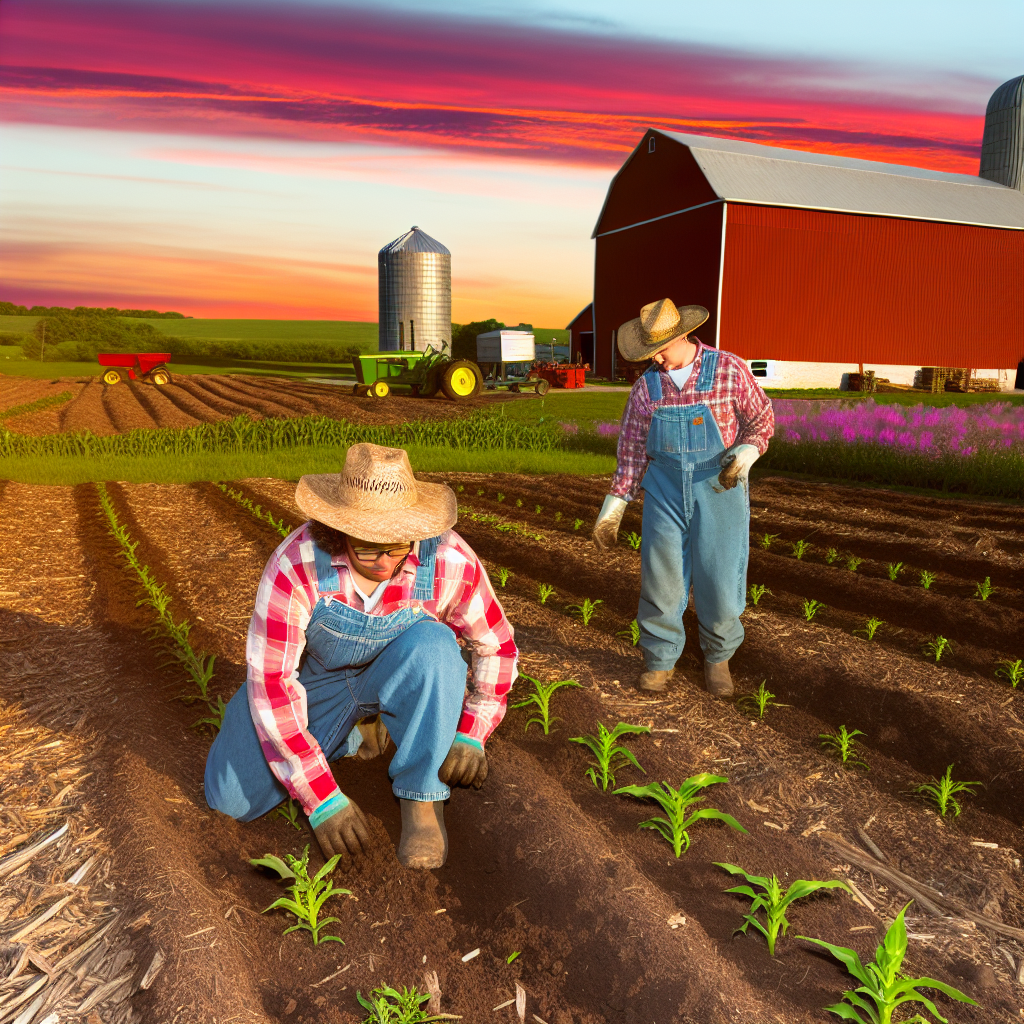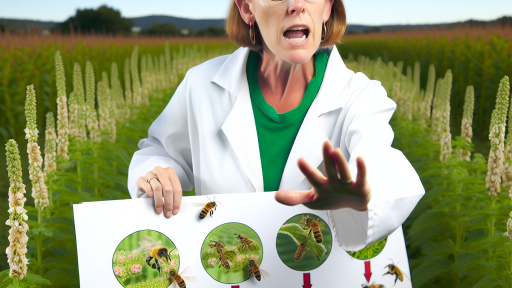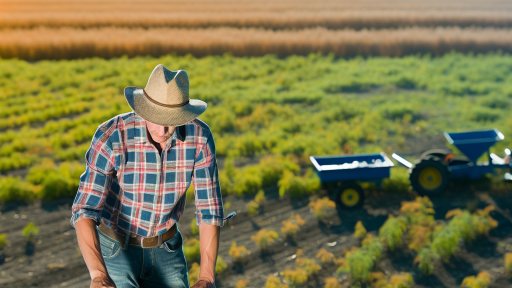Understanding the Importance of Native Species in Farming
Enhancing Biodiversity
Integrating native species greatly enhances biodiversity on farms.
This diversity is critical for maintaining healthy ecosystems.
It provides habitats for local wildlife and promotes species interaction.
Moreover, diverse ecosystems are more resilient to environmental changes.
Improving Soil Health
Native plants enhance soil health through natural processes.
They contribute organic matter and nutrients back into the soil.
Additionally, native plants improve soil structure and water retention.
This ultimately leads to better crop yields and sustainable farming.
Reducing Pest Control Needs
Using native species can naturally reduce pest populations.
They attract beneficial insects that control pests effectively.
This method decreases the need for chemical pesticides.
Thus, native species promote a healthier farming environment.
Adapting to Local Climate
Native species are well-adapted to local climate conditions.
This makes them easier to cultivate and maintain over time.
Farmers can rely on them for consistent yields despite changing weather.
Transform Your Agribusiness
Unlock your farm's potential with expert advice tailored to your needs. Get actionable steps that drive real results.
Get StartedConsequently, native species significantly enhance farm resilience.
Strengthening Community Connections
Integrating native species fosters a connection with local communities.
It raises awareness about the importance of conservation.
Moreover, engaging with local stakeholders promotes knowledge sharing.
This collaboration can lead to more sustainable farming practices.
Assessing Your Farm’s Current Biodiversity
Understanding Biodiversity
Biodiversity encompasses the variety of life on Earth.
This includes different species, habitats, and ecosystems.
In farming, biodiversity enhances resilience and productivity.
Higher biodiversity leads to improved pest control and soil health.
Evaluating Existing Species
Begin by cataloging existing flora and fauna on your farm.
Identify native and non-native species present in your area.
To help, consider using tools like species observation apps.
Engage local conservation groups for assistance in identification.
Assessing Habitat Diversity
Examine various habitats on your farm, such as fields and wetlands.
Each habitat type supports different plant and animal species.
For example, riparian zones attract birds and insects.
Document the unique features of each habitat area.
Analyzing Soil Health
Soil health plays a crucial role in maintaining biodiversity.
Conduct soil tests to assess nutrient levels and microbial activity.
Healthy soils promote diverse plant growth and greater fauna.
Incorporate practices that enhance soil structure and fertility.
Identifying Gaps in Biodiversity
After your assessment, look for areas lacking biodiversity.
Consider adding native plants to support local wildlife.
Evaluate if you need to reduce invasive species on your farm.
Showcase Your Farming Business
Publish your professional farming services profile on our blog for a one-time fee of $200 and reach a dedicated audience of farmers and agribusiness owners.
Publish Your ProfileCreating diverse habitats will attract various organisms.
Engaging Your Community
Encourage community involvement in enhancing farm biodiversity.
Host workshops to educate neighbors about native species.
Share your assessment findings with local farmers and stakeholders.
Collaborate on initiatives to promote biodiversity in your area.
Benefits of Integrating Native Species for Soil Health
Enhancing Soil Structure
Integrating native species improves soil structure significantly.
Their root systems create channels, which increases aeration.
This aeration allows water to penetrate deeper into the soil.
Consequently, it reduces surface runoff and erosion.
Improving Nutrient Cycling
Native species contribute to efficient nutrient cycling in soils.
These plants have adapted to local conditions, enhancing nutrient uptake.
As a result, they help maintain essential nutrients in the soil.
Moreover, their decomposition enriches the organic matter content.
Promoting Microbial Diversity
Integrating native plants fosters diverse microbial communities in the soil.
Diverse microbes enhance soil health through symbiotic relationships.
These interactions improve nutrient availability for crops.
Additionally, a healthy microbial population can suppress soil-borne diseases.
Reducing Soil Compaction
Native plants can effectively reduce soil compaction.
Their deep roots help to break up compacted layers in the soil.
Furthermore, this promotes better water infiltration and root growth.
Enhancing Water Retention
Native species improve the ability of soil to retain moisture.
Their presence creates a balance in the soil’s water-holding capacity.
This is particularly beneficial during dry periods or drought conditions.
Supporting Ecosystem Services
Integrating native species supports various ecosystem services.
These services include pollination, pest control, and habitat provision.
Additionally, they help in carbon sequestration, mitigating climate change.
Encouraging Resilience to Climate Change
Native plants are typically more resilient to local climate conditions.
They withstand extreme weather, which helps stabilize farmland.
This resilience ensures continuous productivity despite climatic variations.
Delve into the Subject: Soil Health and Carbon Sequestration Techniques
How to Choose Suitable Native Species for Your Farm
Assess Your Farm’s Environment
Begin by analyzing your farm’s soil type and pH level.
Consider the climate conditions such as temperature and humidity.
Additionally, evaluate water availability and drainage characteristics.
These factors significantly influence which native species will thrive.
Research Local Native Species
Identify native plants and species that are well-suited for your area.
Consult local agricultural extension services for guidance.
Additionally, seek advice from local conservation organizations.
Such resources can provide valuable insights into native biodiversity.
Evaluate Compatibility with Existing Crops
Consider how native species will interact with your current crops.
Ensure they do not compete for resources excessively.
Showcase Your Farming Business
Publish your professional farming services profile on our blog for a one-time fee of $200 and reach a dedicated audience of farmers and agribusiness owners.
Publish Your ProfileAlso, look for species that can benefit your crops, such as pollinators or pest predators.
This balance can enhance overall farm productivity.
Plan for Sustainable Practices
Integrate native species into your farm’s sustainable management practices.
Consider how they can improve soil health through natural processes.
Also, explore options for planting native species in buffers or hedgerows.
These strategies can help manage runoff and enhance ecosystem services.
Seek Expertise and Community Support
Engage with local farmers who have experience with native species.
Join agricultural workshops or community forums focused on sustainable practices.
Networking can lead to valuable partnerships and shared knowledge.
Such support aids in effectively integrating native species into your farming system.
Explore Further: Benefits of Integrated Pest Management in Farming
Best Practices for Planting and Managing Native Species
Choosing the Right Native Species
Selecting appropriate native species is essential for success.
Research local flora to find plants that thrive in your region.
Consider the soil type, moisture levels, and sunlight in your area.
Consult with local nurseries or extension services for advice.
Choose species that attract beneficial wildlife, such as pollinators.
Planning the Planting Layout
Creating a thoughtful layout optimizes growth and maintenance.
Group similar plants based on their water and sunlight needs.
Use companion planting techniques to enhance growth and repel pests.
Leave adequate space between plants for airflow and growth.
Consider seasonal changes and how they affect sunlight and moisture.
Implementing Soil Conservation Techniques
Healthy soil is vital for planting native species.
Utilize cover crops to improve soil health and prevent erosion.
Add organic matter to enhance soil structure and fertility.
Conduct soil tests to determine nutrient deficiencies.
Adjust your soil management practices based on test results.
Watering and Irrigation Practices
Proper watering techniques support plant establishment and growth.
Implement drip irrigation systems to minimize water waste.
Water deeply and infrequently to encourage deep root growth.
Monitor weather conditions to adapt your watering schedule.
Use mulch to retain soil moisture and suppress weeds.
Monitoring and Managing Pests
Integrated pest management keeps native plants healthy.
Regularly inspect plants for signs of pest damage or disease.
Implement biological control methods to manage pests naturally.
Encourage beneficial insects that prey on harmful pests.
Avoid using chemical pesticides to protect local ecosystems.
Maintaining Biodiversity
Diversity boosts ecosystem resilience and enhances farm productivity.
Incorporate a variety of native species in your planting plan.
Rotate crops and diversify plantings to prevent soil depletion.
Create habitats for wildlife to sustain a balanced ecosystem.
Showcase Your Farming Business
Publish your professional farming services profile on our blog for a one-time fee of $200 and reach a dedicated audience of farmers and agribusiness owners.
Publish Your ProfileEngage in community efforts to promote local biodiversity.
See Related Content: Organic Farming and Carbon Sequestration Benefits

Creating Habitats to Support Native Wildlife on Farms
Importance of Native Habitats
Native habitats are crucial for supporting local wildlife.
These habitats provide food, shelter, and breeding grounds.
Incorporating native species enhances biodiversity on your farm.
Moreover, healthy ecosystems improve soil health and water quality.
Designing Effective Habitats
Start by assessing your farm’s landscape.
Identify areas that can be converted into wildlife-friendly spaces.
Consider planting native grasses, shrubs, and trees.
These plants attract pollinators and provide habitat for birds.
Creating a Variety of Microhabitats
Diversity in habitat types benefits a wide range of species.
Create wetland areas to support amphibians and insects.
Incorporate hedgerows for small mammals and nesting birds.
Use brush piles to provide shelter for small wildlife.
Incorporating Water Sources
Water sources are vital for attracting wildlife.
Consider installing small ponds or birdbaths.
Ensure water is clean and accessible for animals.
Monitor these areas to maintain healthy ecosystems.
Utilizing Native Plants
Native plants are adapted to local conditions.
Choose plants that thrive in your specific climate and soil type.
Planting native species reduces the need for chemical inputs.
This fosters a healthier environment for all organisms.
Engaging with Local Conservation Efforts
Collaborate with local conservation organizations.
These groups can provide valuable resources and guidance.
Engaging with the community fosters greater awareness.
It strengthens the impact of your habitat creation efforts.
Monitoring and Managing Habitats
Regular monitoring is essential to maintain habitat quality.
Keep track of wildlife usage and plant health.
Adjust management practices based on findings.
This ensures ongoing support for local wildlife populations.
Uncover the Details: Implementing Recycling Systems on Your Farm
Integrating Native Species into Crop Rotation and Permaculture
The Importance of Native Species
Native species play a crucial role in sustainable farming systems.
They enhance biodiversity and improve ecosystem resilience.
Incorporating them can lead to healthier soil and increased crop yields.
Understanding Crop Rotation
Crop rotation involves alternating the types of crops grown on a specific land area.
It prevents nutrient depletion and disrupts pest life cycles.
Integrating native plants into this system optimizes benefits significantly.
Selecting Native Crops
Choose native plants that thrive in your local climate and soil.
Research their growth patterns and ideal planting conditions.
Popular native crops include echinacea, black-eyed Susans, and milkweed.
Showcase Your Farming Business
Publish your professional farming services profile on our blog for a one-time fee of $200 and reach a dedicated audience of farmers and agribusiness owners.
Publish Your ProfileBenefits of Native Crop Integration
Integrating native species into crop rotation improves soil health.
It enhances pollinator activity and attracts beneficial insects.
Furthermore, it reduces reliance on chemical fertilizers and pesticides.
Permaculture Principles
Permaculture promotes sustainable land management techniques.
This approach designs agricultural landscapes based on natural ecosystems.
Native species are essential to achieving these design principles.
Creating Biodiverse Environments
Incorporate various native plants into permaculture designs.
Diversity encourages resilient ecosystems that support various wildlife.
It also creates a balanced environment with reduced pest populations.
Water Management and Native Species
Native plants often require less water than non-native varieties.
They adapt well to local rainfall patterns, ensuring resource efficiency.
Integrating them helps in maintaining optimal water management on farms.
Community and Economic Benefits
Using native species can foster community resilience and local economies.
They attract tourism through unique landscapes and native wildlife.
Farmers can market native products distinctively, increasing profitability.
Engaging Local Communities
Educate local communities about the importance of native species.
Workshops and farm tours can raise awareness and interest.
A collaborative approach promotes community involvement in conservation efforts.
Creating Market Opportunities
Identify local markets that appreciate native species.
These can include farmers’ markets, local restaurants, and specialty shops.
Promoting native farm products can lead to sustainable economic development.
Monitoring and Evaluating the Impact of Native Species on Farm Productivity
The Importance of Monitoring
Monitoring is essential for understanding the effects of native species on farm productivity.
It allows farmers to track changes over time.
Regular data collection provides insights into the ecosystem health.
Setting Baselines
Establishing a baseline is the first step in effective monitoring.
Collect data on current productivity levels without native species.
This data serves as a comparison point for future evaluations.
Data Collection Methods
Use various data collection methods to assess productivity.
Field observations can provide immediate insights into crop health.
Soil tests measure nutrient levels and microbial activity.
Additionally, surveys can gather qualitative data on pest populations.
Analyzing Data
Data analysis reveals patterns and trends in productivity.
Compare the productivity levels before and after integrating native species.
Use statistical software to identify significant changes.
Evaluating Ecosystem Health
Beyond productivity, native species influence overall ecosystem health.
Monitor biodiversity levels to ensure a balanced ecosystem.
Track the presence of beneficial insects and pollinators.
Feedback Mechanisms
Implement feedback mechanisms to make informed decisions.
Adjust management practices based on monitoring results.
Engage with agricultural advisors for expert insights.
Showcase Your Farming Business
Publish your professional farming services profile on our blog for a one-time fee of $200 and reach a dedicated audience of farmers and agribusiness owners.
Publish Your ProfileLong-Term Assessment
Continuous monitoring provides long-term perspectives on productivity.
Regular assessments help identify trends over seasons and years.
Consider establishing a schedule for reevaluating baseline data.
Sharing Results
Communicate findings with the agricultural community.
Share successes and challenges with integrating native species.
This fosters collaborative learning and improvement in practices.
Additional Resources
Center for Integrated Agricultural Systems – University of Wisconsin …




